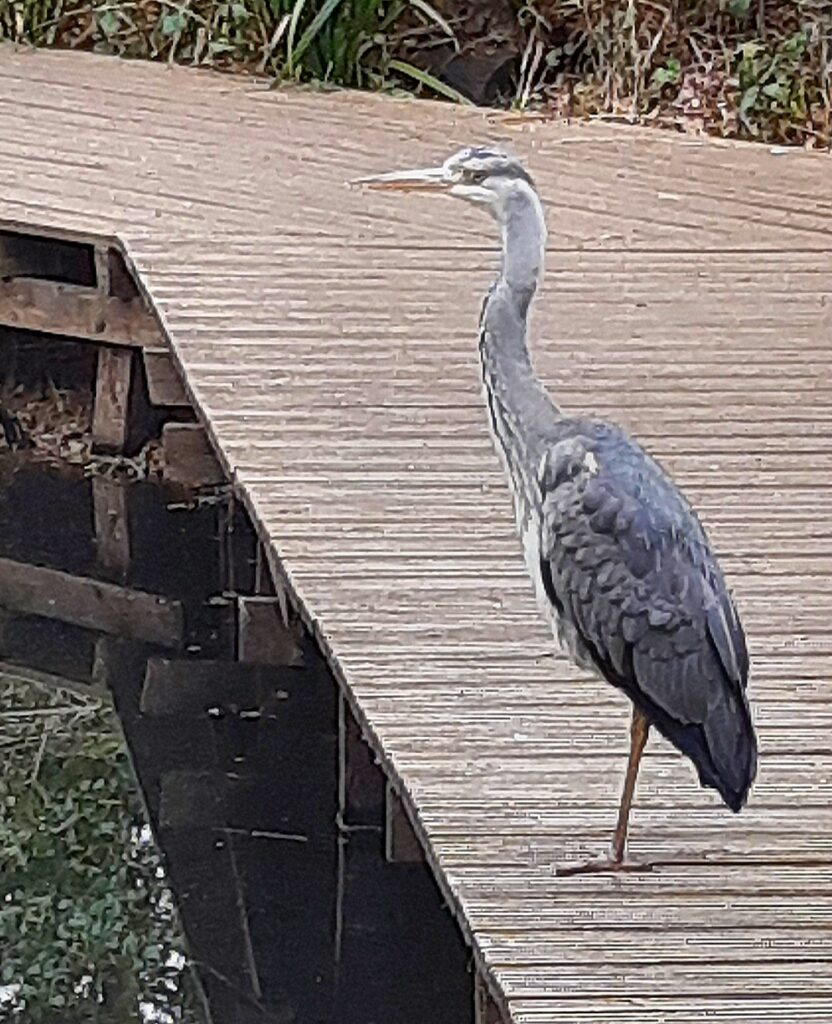
Solitary Visitor on Gunnersbury Triangle Boardwalk


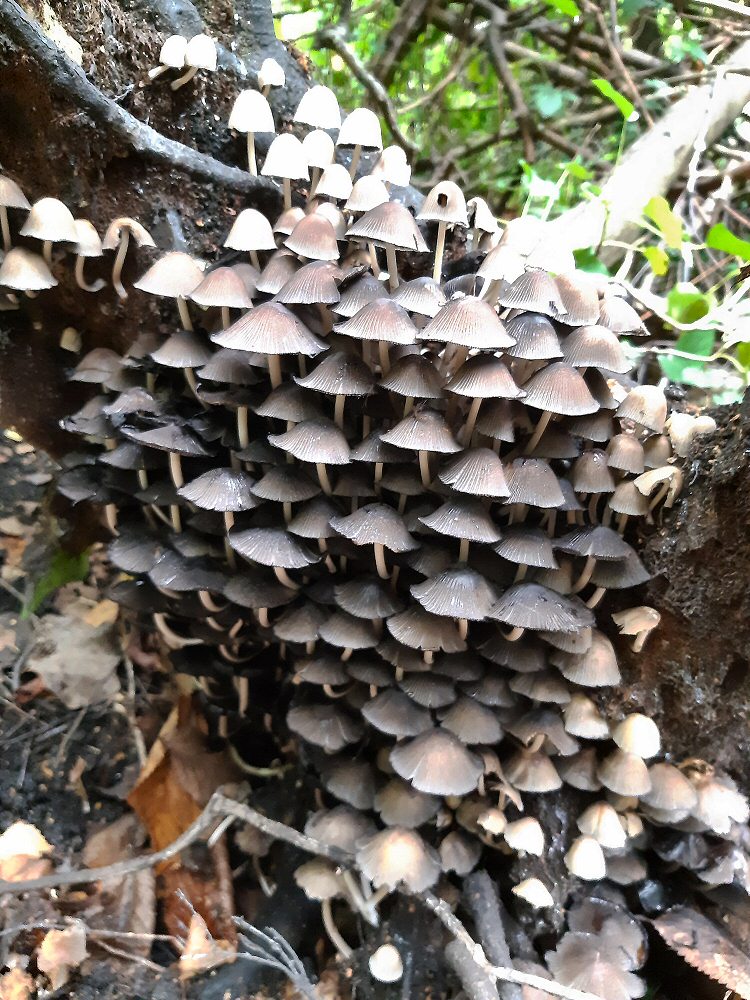
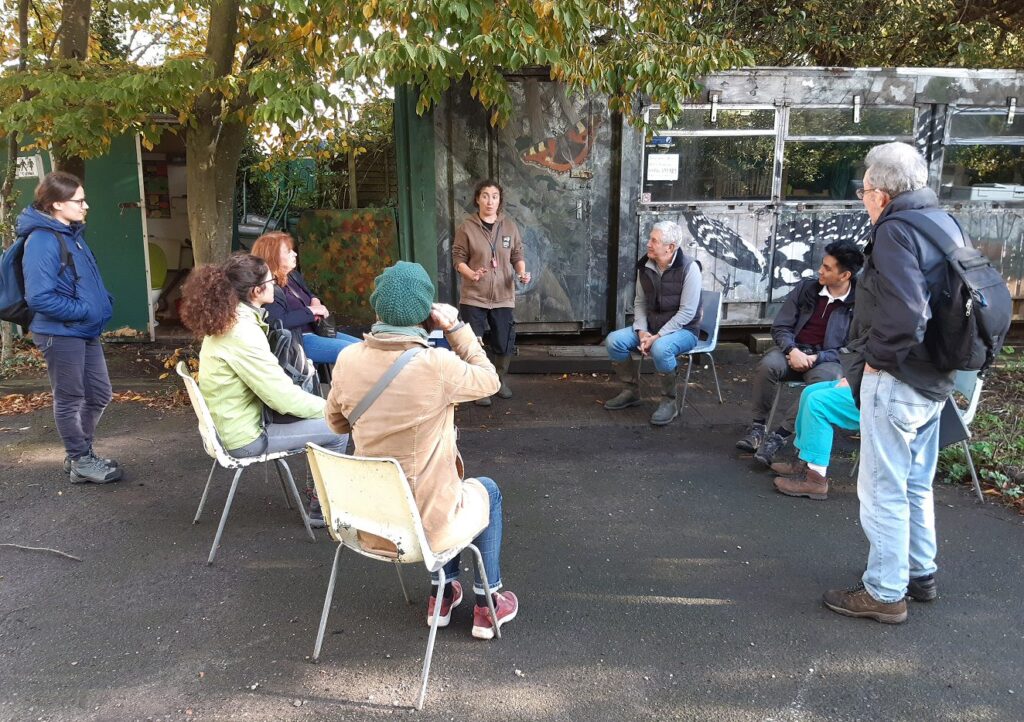
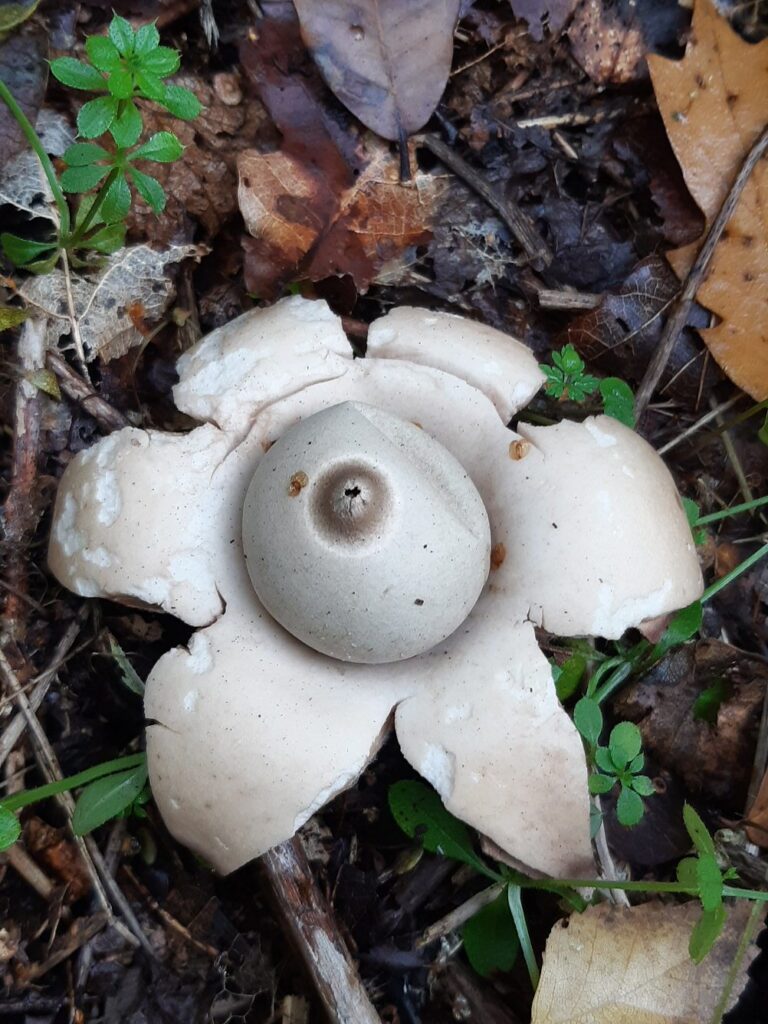
Well, here is the list that I wrote down as we went round. I’m sure that Alick Henrici who was leading the group named more species than this, and he also declined to name several difficult species which he collected in his little box to take for analysis back at Kew by his colleague Geoffrey Kibbey! Still, the fact that the group found so many – and there was no doubt at all that having more pairs of eyes resulted in more finds – was surprising to most people present. We walked anticlockwise around the reserve, and found the species in the order shown.
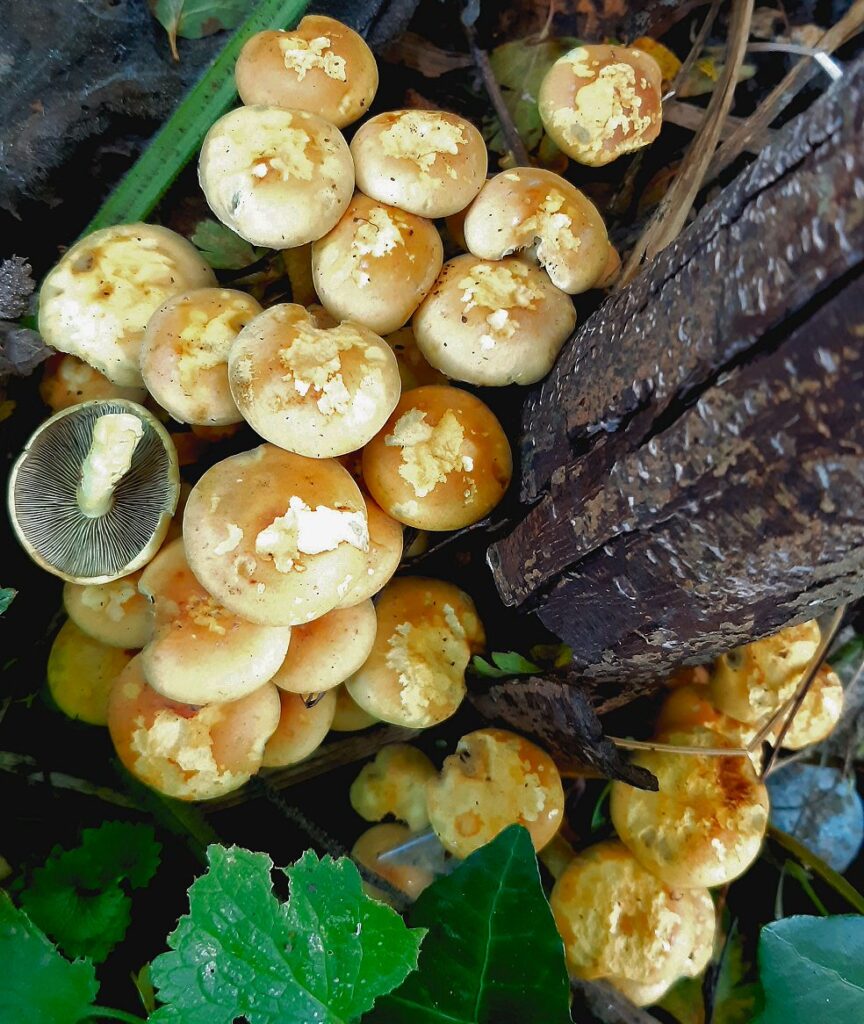
Trametes (Coriolus) versicolor, the Turkeytail, a very common but elegant little bracket, forming troops on fallen branches and logs. The name Coriolus seems like the Coriolis effect that makes storms whirl around, and it does have a whirly effect on its patterned top surface.
Stereum hirsutum, another very common species, the Hairy Curtain Crust or False Turkeytail, forms a white crust on logs, its top gently velvety (hence ‘hirsutum’, hairy), with no pores
An Ascomycete, a spore-shooting fungus with its spores 4 in a row under the microscope, forming firm little brown balls on logs.
Schizopora paradoxa, thin white layer on logs
Piptoporus betulinus, the Birch Polypore or Razorstrop Fungus – when dried it was used to put a polish on the old Sweeney Todd the Barber type of cutthroat razor! Finding it is practically guaranteed on dead Birch wood, standing or fallen.
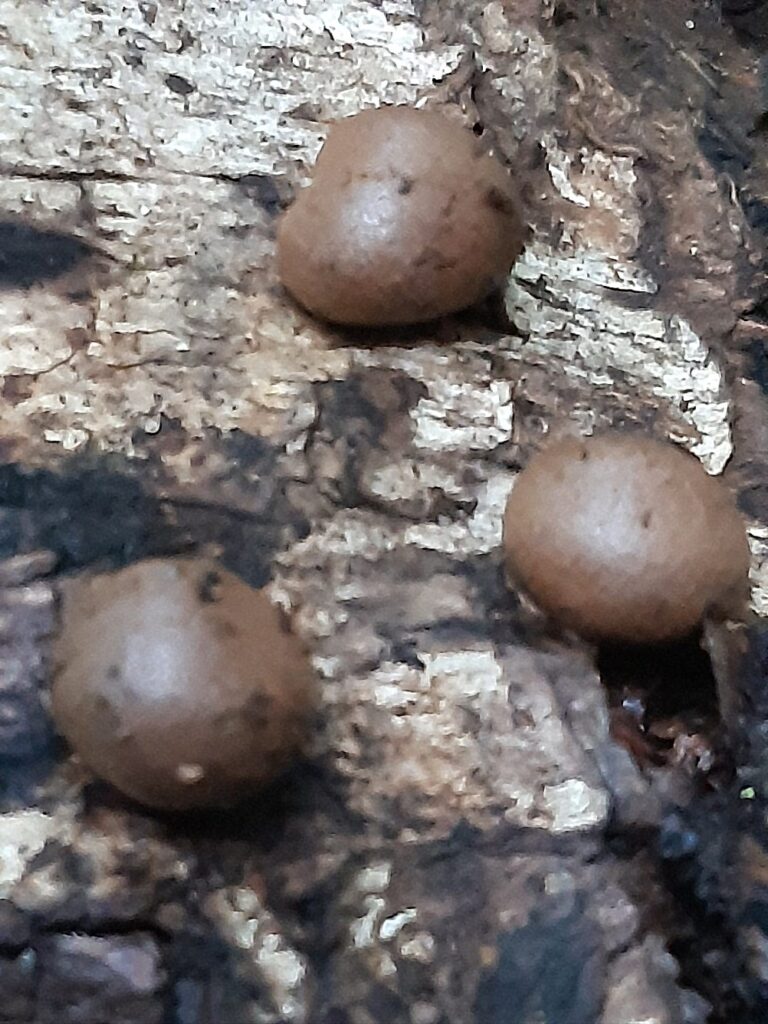
A slime mould, forming small squashy grey-brown blobs on rotting logs.
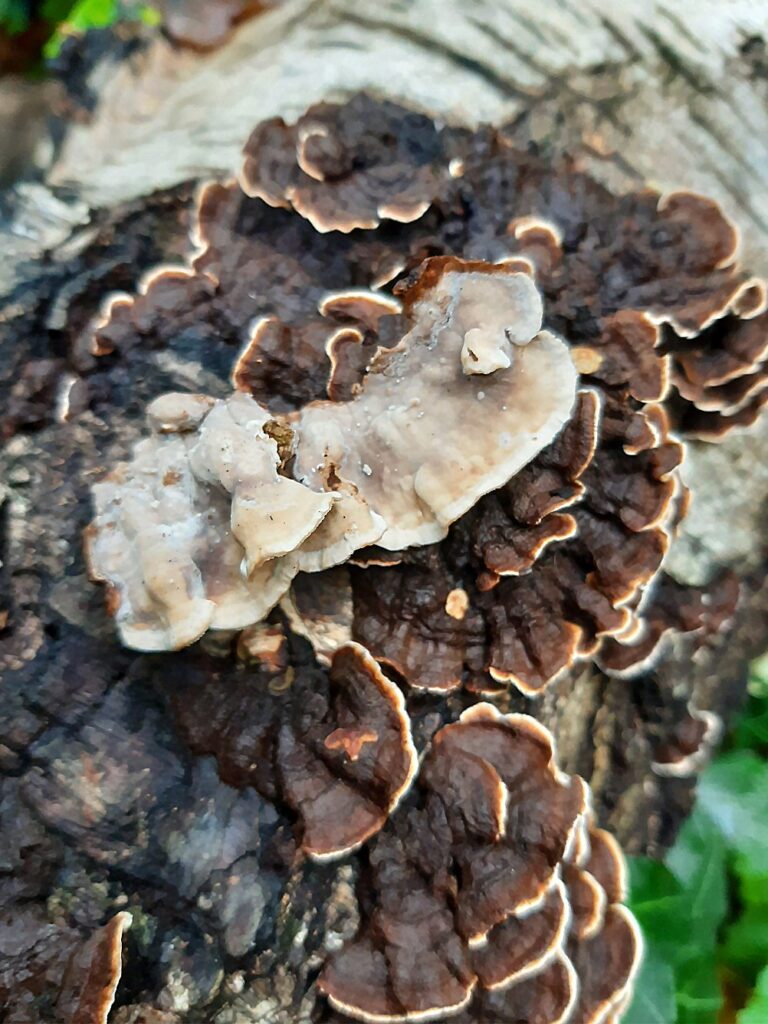
Dark trooping bracket Laxitextum bicolor, new to UK in last 5 years, first record from Gunnersbury Triangle today! Alick said it seemed to be making itself quite at home, and indeed while those of us who recognise a few of the common brackets couldn’t have placed this species, we’d never have guessed it was brand new.
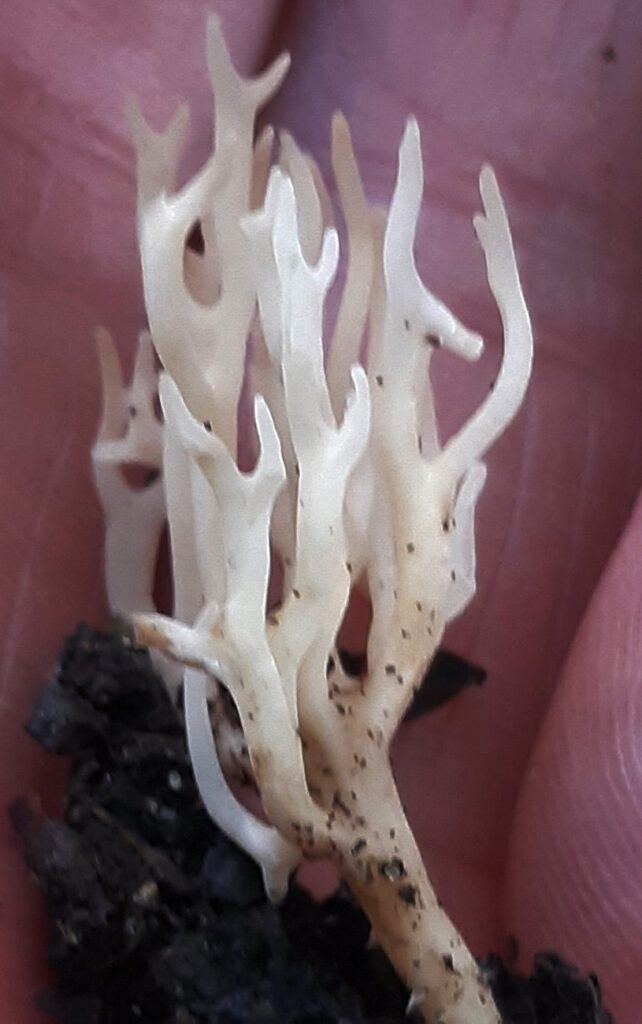
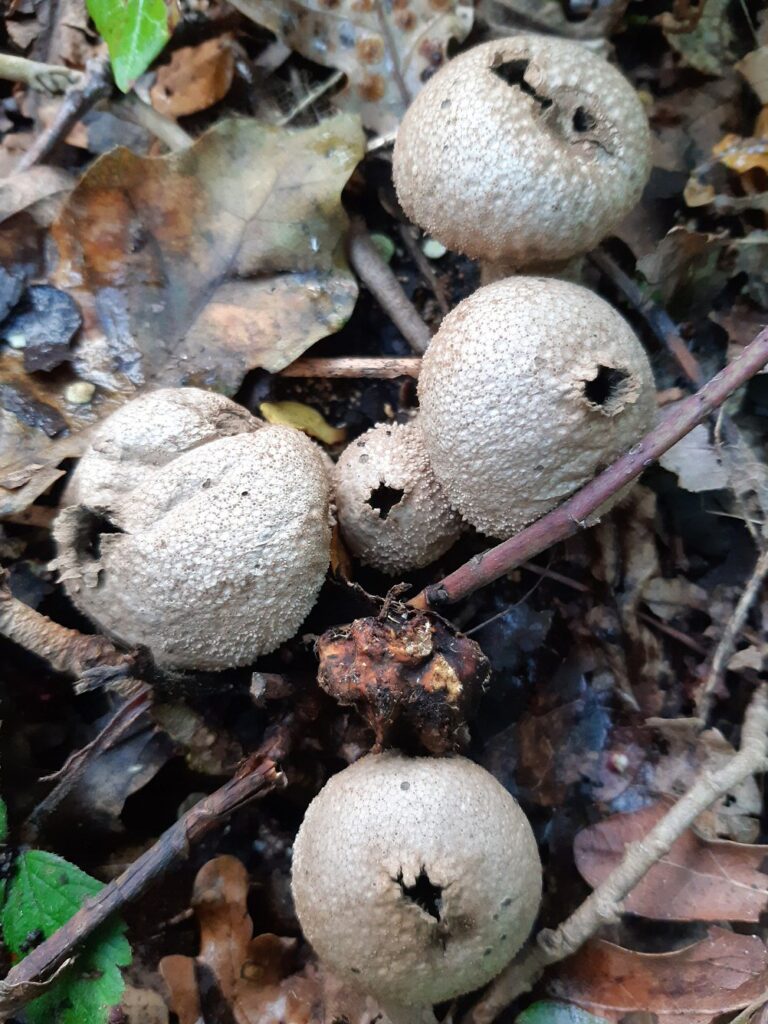
Lycoperdum perlatum, the common Puffball. Alick told us the marvellously funny etymology of the name: Lykos is Greek for wolf, perdon for fart, and perlatum is Latin for pearly, meaning the surface decoration. Perhaps the puff of brown spores when you touch an old specimen is the wolf’s fart, who knows.
Mycena spp.
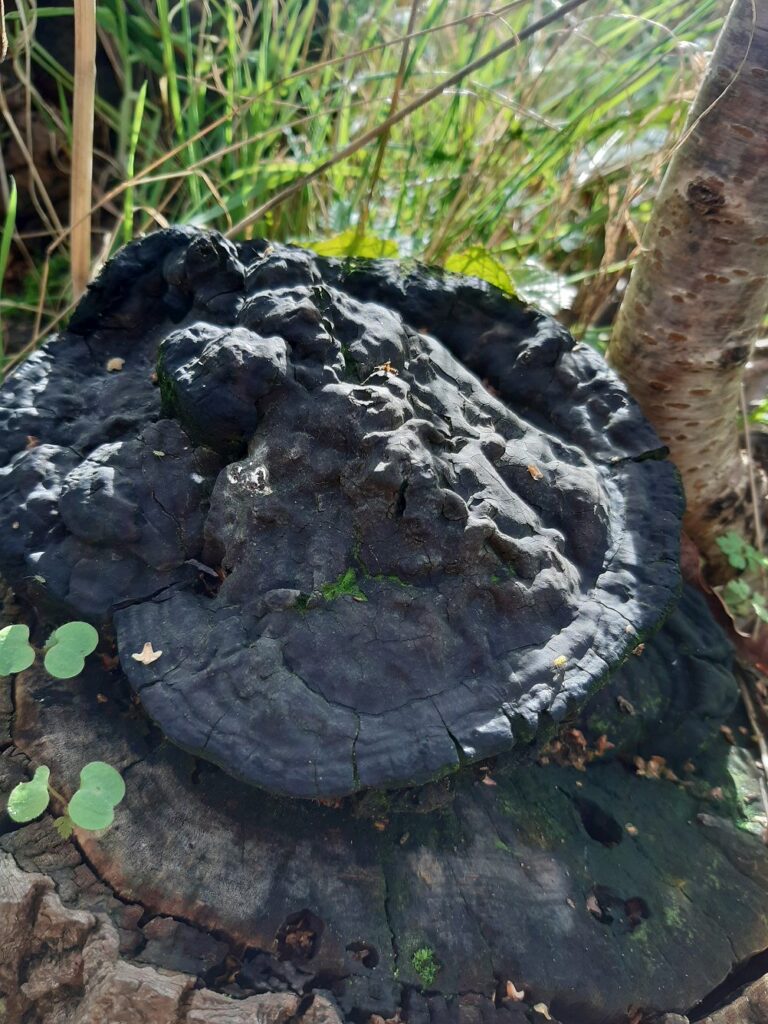
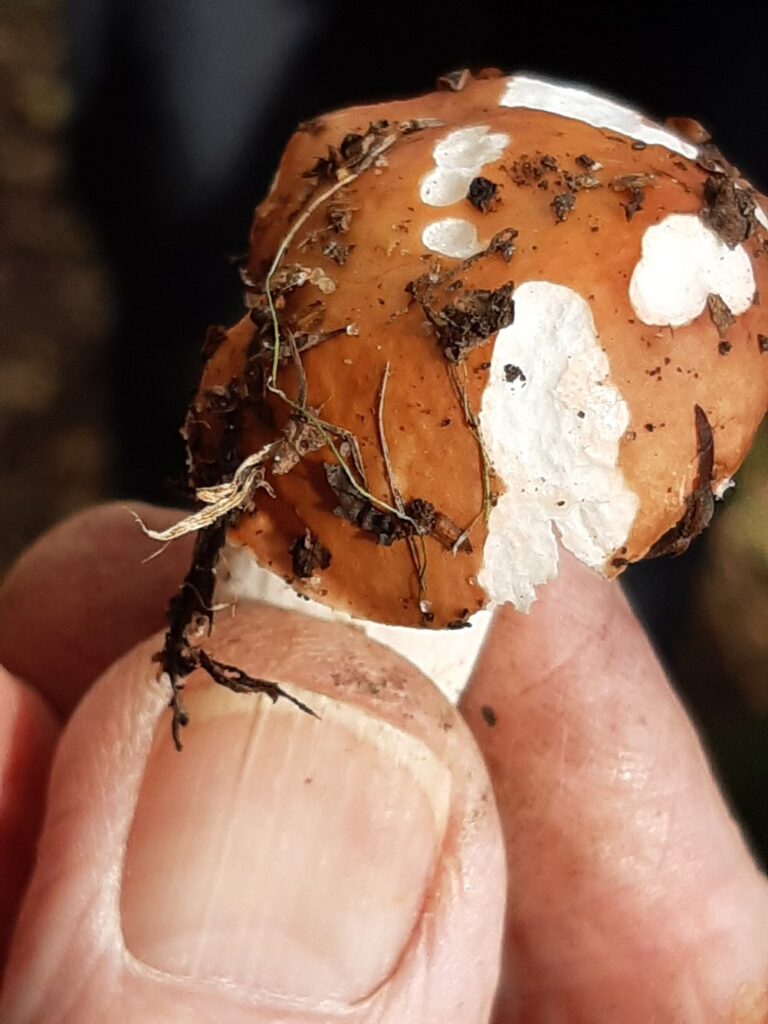
Tricholoma album
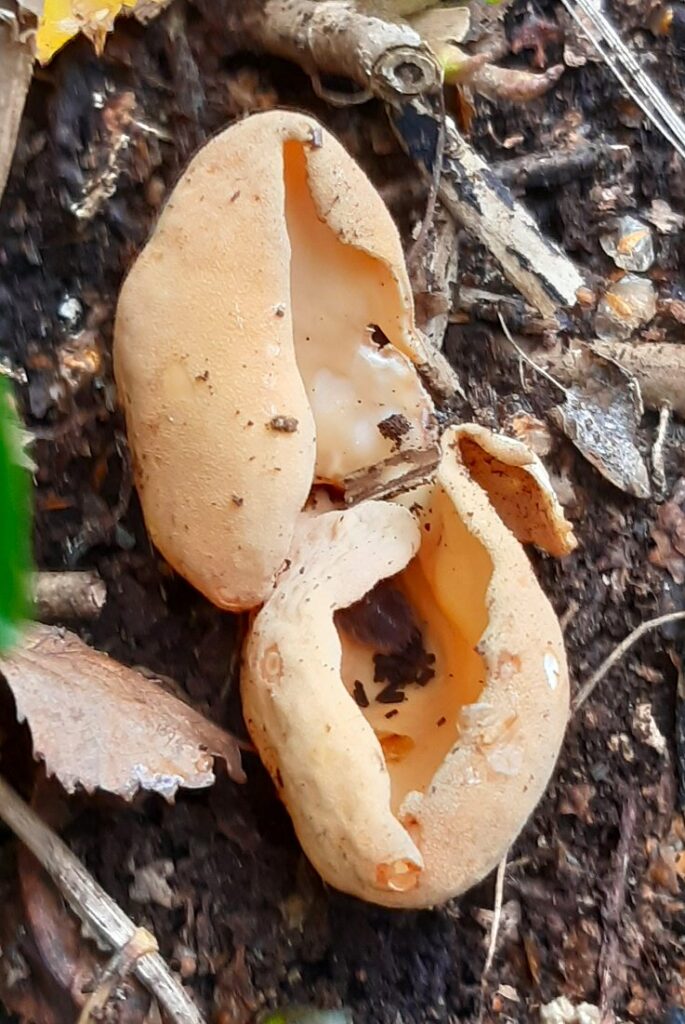
Hebeloma sp., a Poisonpie toadstool
Cortinarius sp. (Webcaps), subgenus Telamonia, a very difficult group, separated by DNA analysis. Into Alick’s box it went!
Geastrum triplex, the Collared Earthstar (photo at top), a really handsome and uncommon fungus. We seem to be getting it every year here now, a delight. Alick has found 3 species of Earthstar here in Gunnersbury Triangle.
Melanoleuca sp., a cavalier mushroom
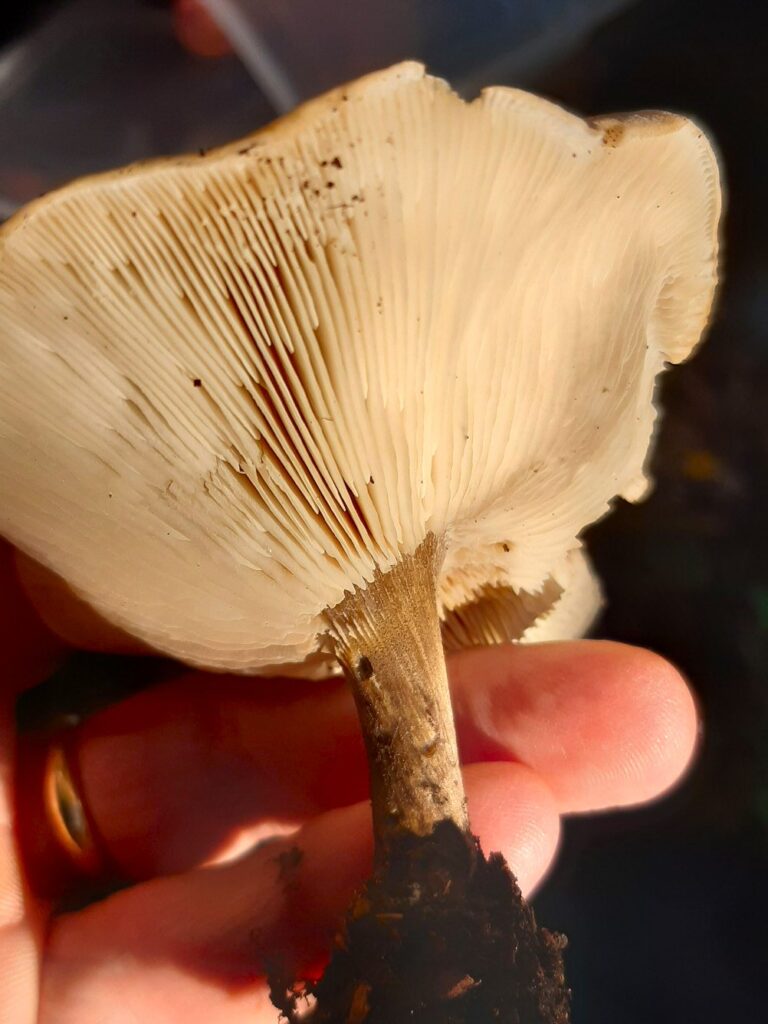
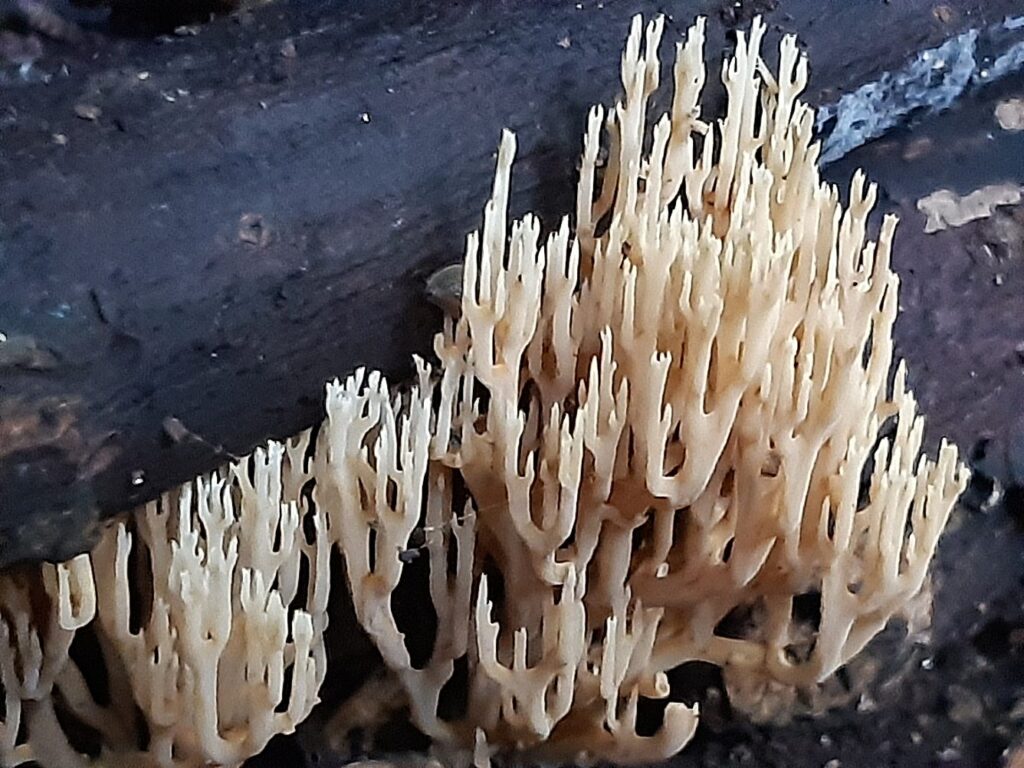
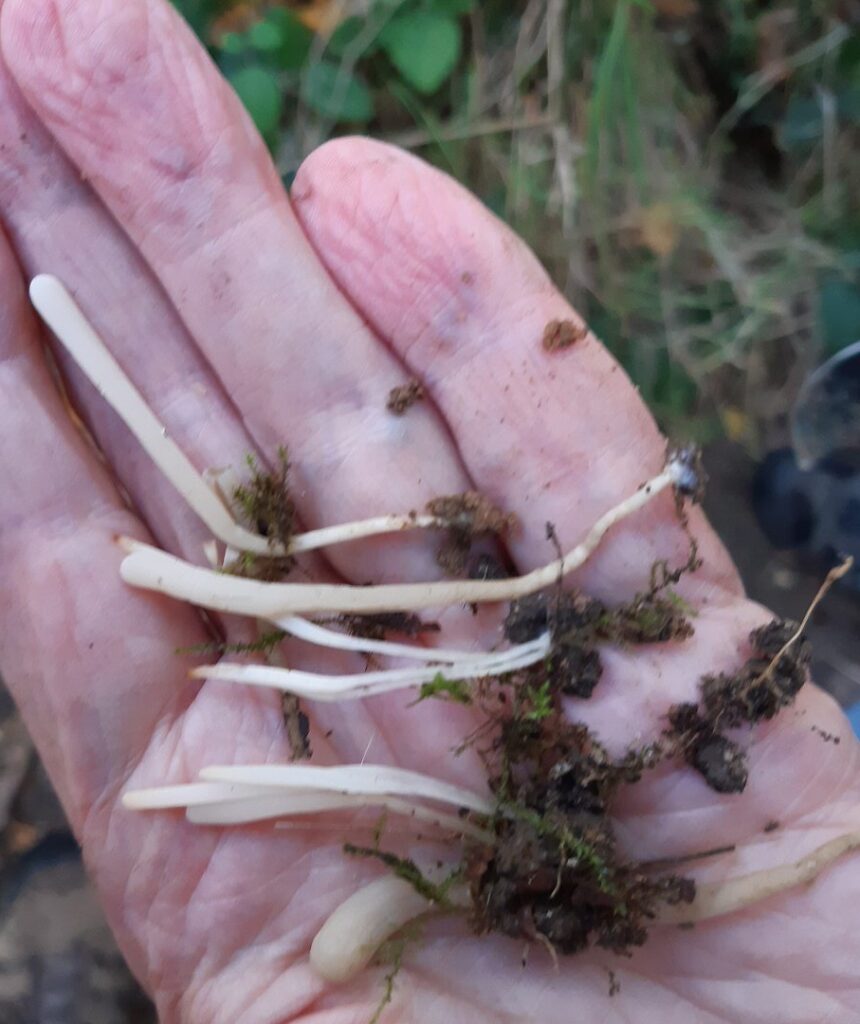
Armillaria mellea, the Honey Fungus, a dangerous parasite of trees, and it continues to flourish as a saprophyte after they are dead, rotting their wood. Its English name is for its warm honey colour. It can be eaten but who’d want to.
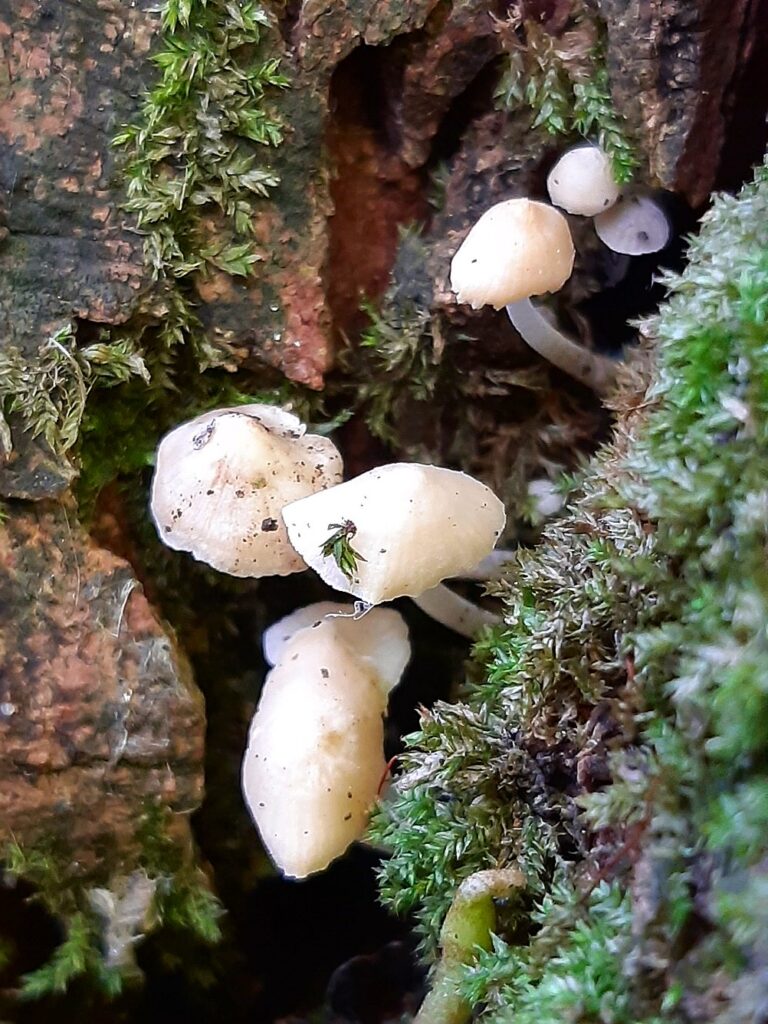
Mycena archangeliana
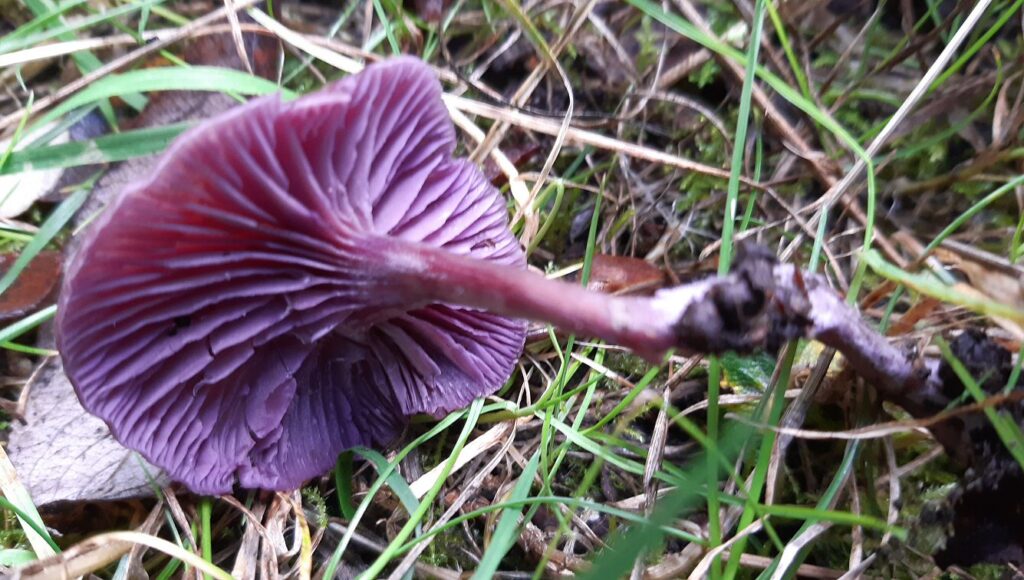
We saw no fewer than 3 species of Deceiver, including Laccaria laccata, the (common) Deceiver, as well as the two illustrated here. The group is well named; beginners collect handfuls of interesting-looking mushrooms of all different shapes, sizes, and appearances, and are crestfallen to discover they’re all the same species!
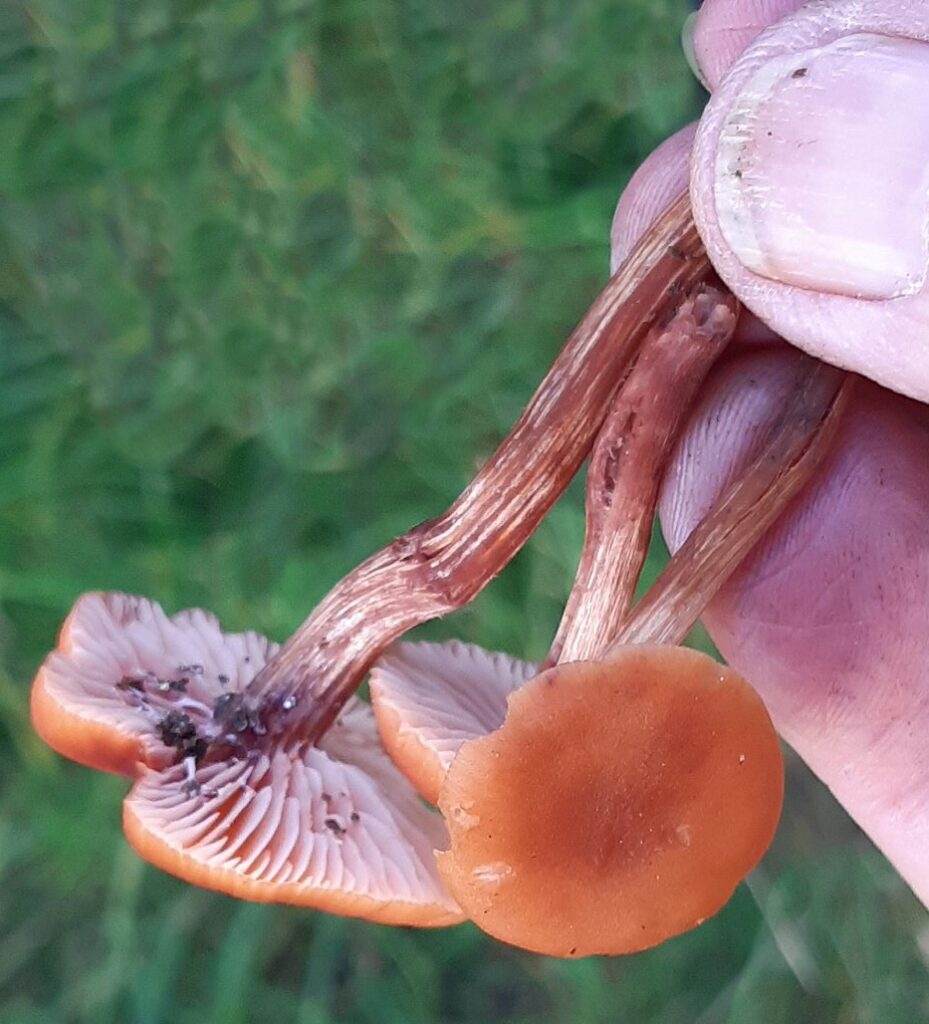
Inocybe geophylla, the white Fibrecap
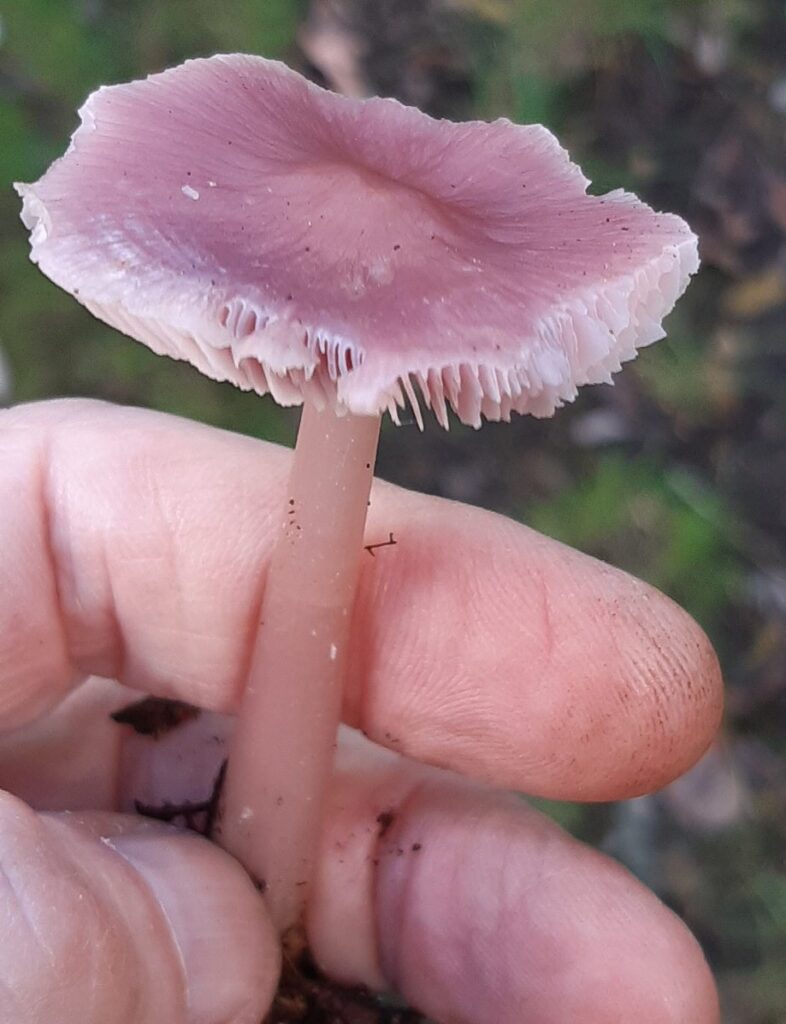
Mycena pura, the very common and variable Lilac Bonnet, another relatively large and attractive bonnet mushroom. The Collins guide says that some think M. rosea is just a form of this species.
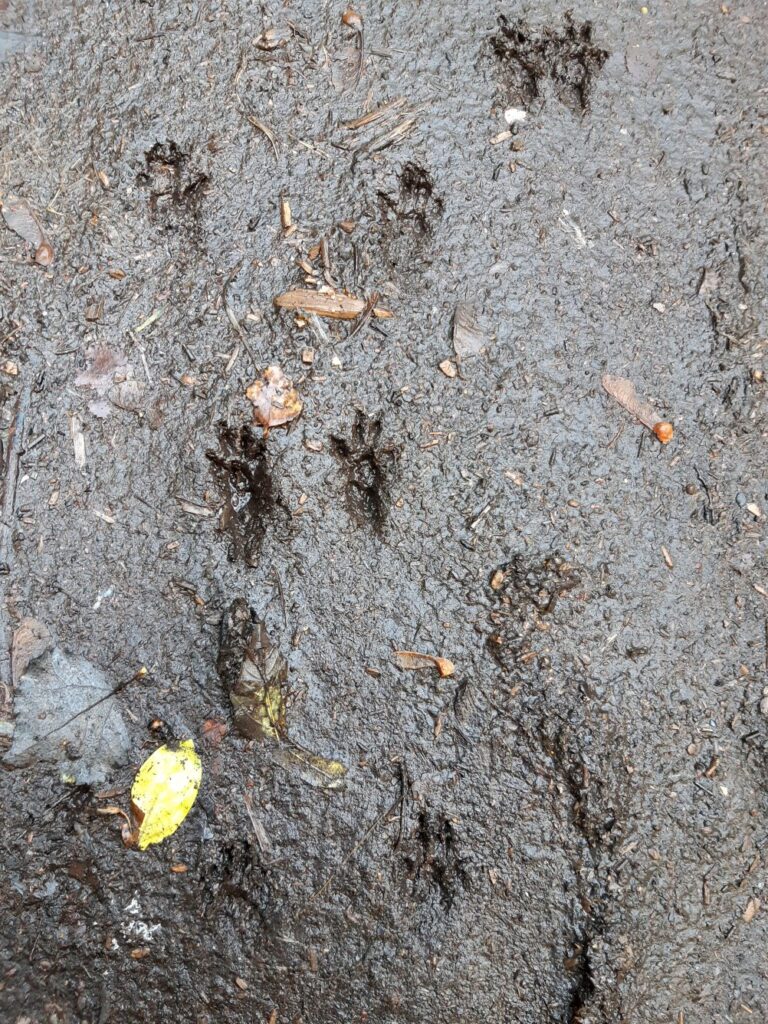
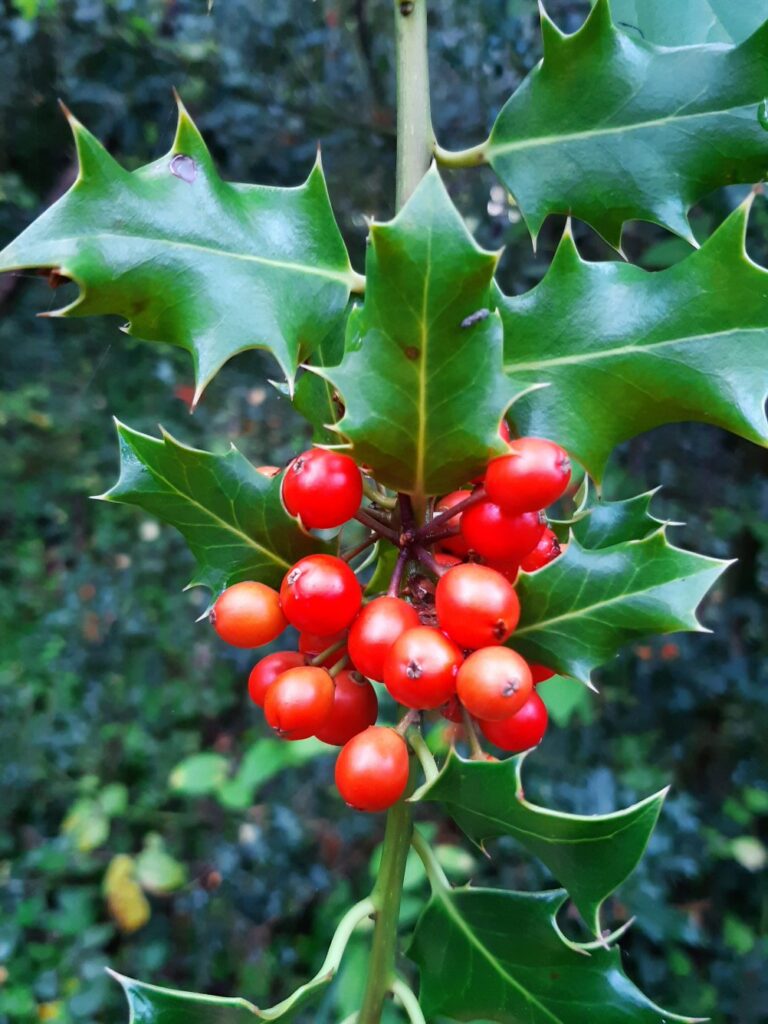
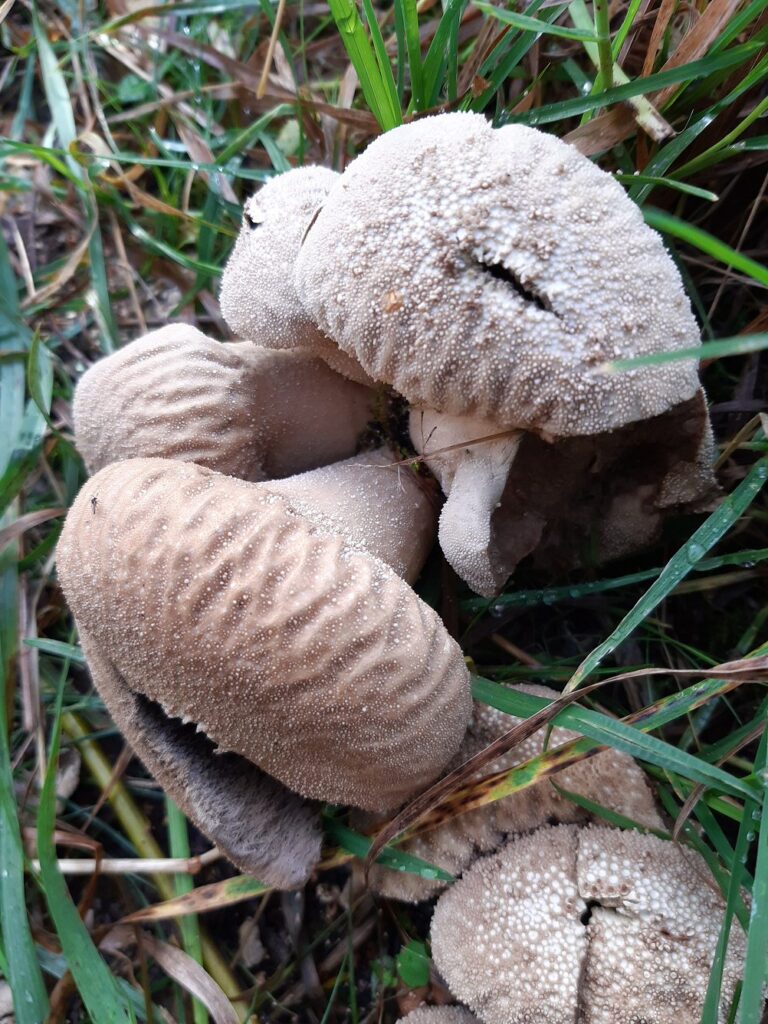
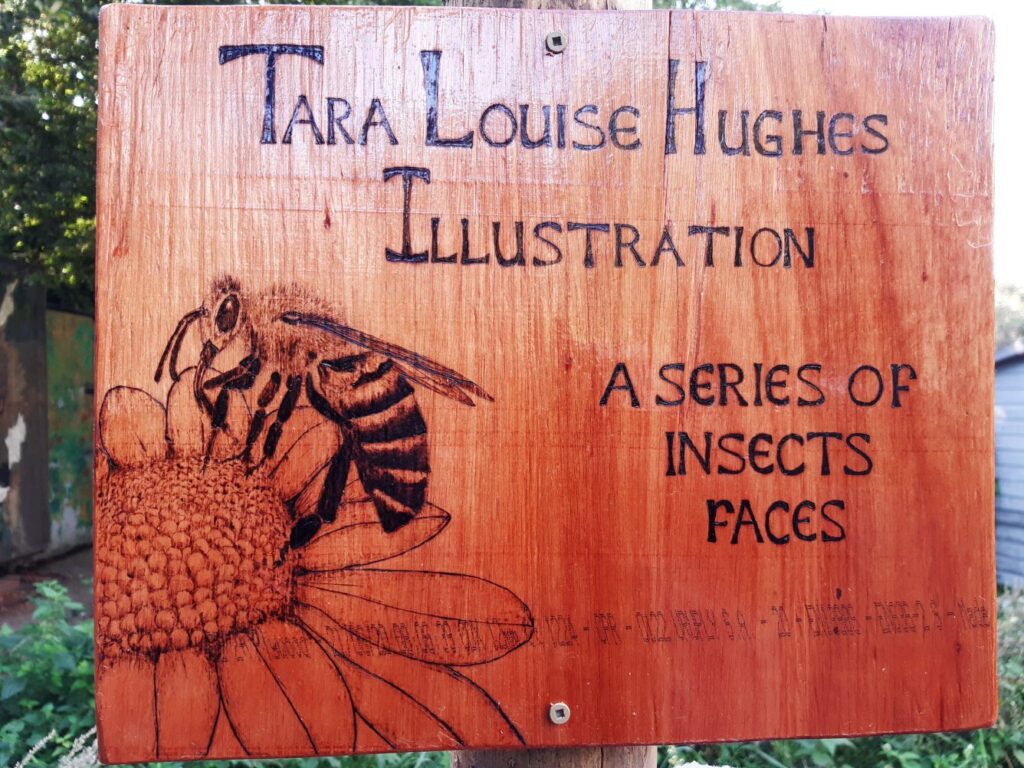
The Gunnersbury Triangle nature reserve this autumn has a new and wonderful nature trail: a series of insects’ faces by Tara Louise Hughes. Tara, when not studying art and illustration, has proven herself a capable conservation volunteer. Now, she has brightened up the reserve for children and adults with her painstakingly fire-etched close-up drawings of insects.

Her damselfly head is a study in miniature detail: the hundreds of pin-point eye-elements (ommatidia) in the insect’s large, forward-facing eyes; the precise distribution and length of the bristles on the top of the head and on the mouthparts; the accurately-observed antennae.
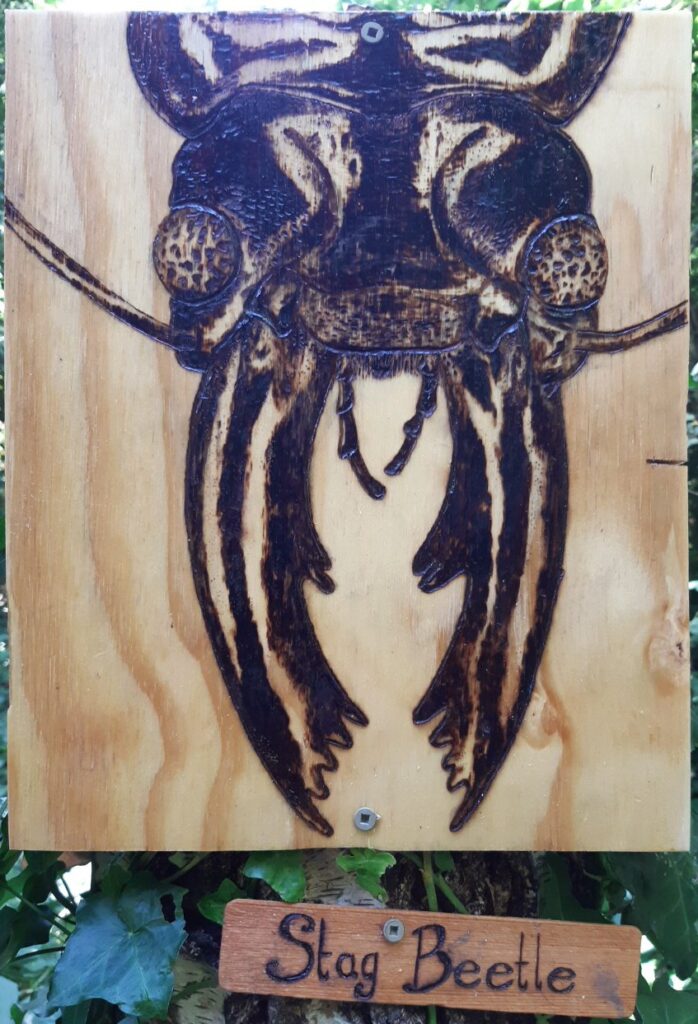
The Stag Beetle head is suitably fearsome, a study in armoured magnificence with interlocking chitin cases for head and thorax, and those extraordinary antler-like mandibles.
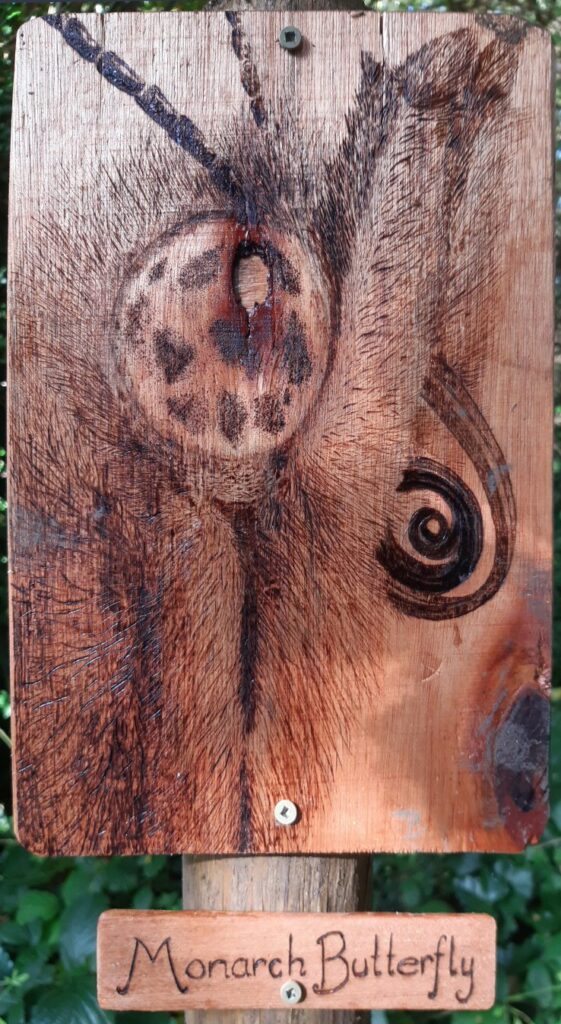
The Monarch Butterfly’s head couldn’t be more different: a study of a delicately furry head, a shy eye, and the tenderly coiled proboscis peeping out on the right.
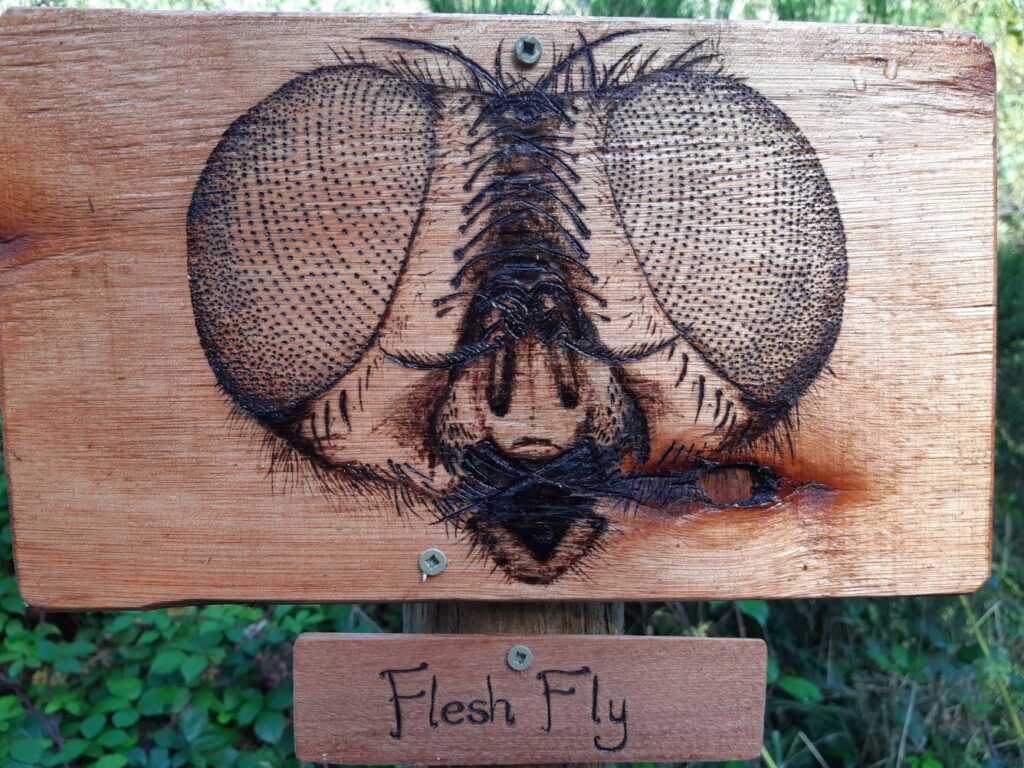
With the Flesh Fly we’re certainly back in scary territory, the rows of stiffly corseted bristles announcing that this insect is ready for action.
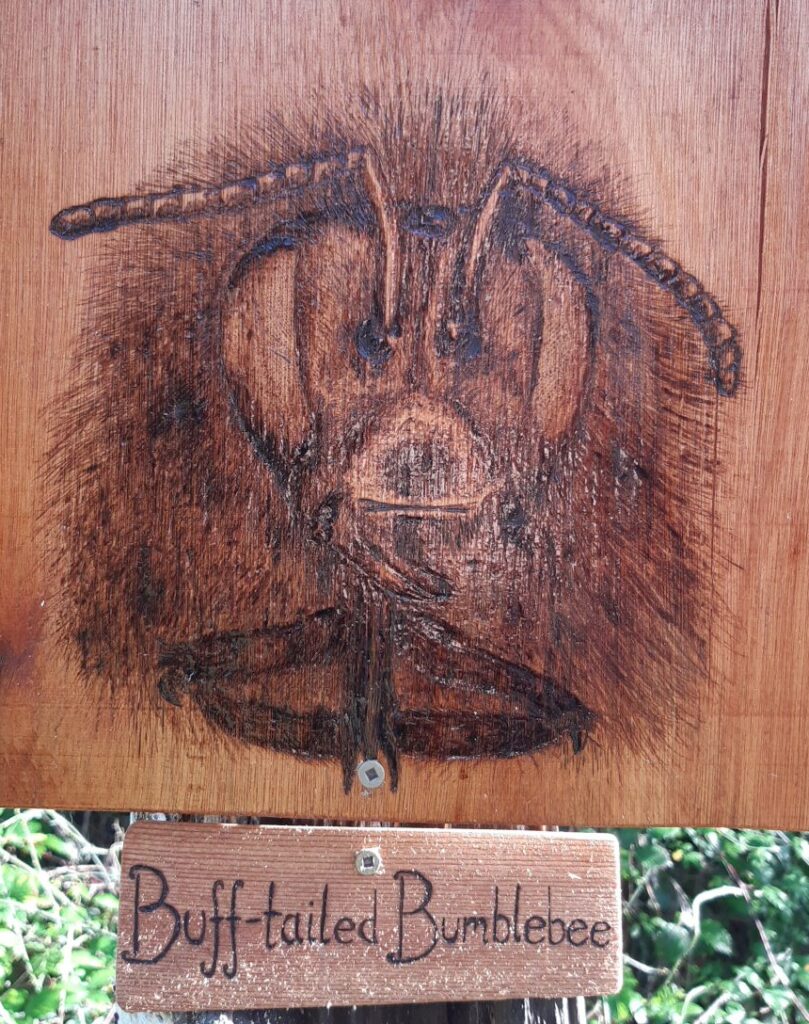
The Buff-tailed Bumblebee, a mild and welcome presence in the reserve, and in gardens wherever there is a suitable supply of flowers. The furry insect seems shy under the artist’s gaze.
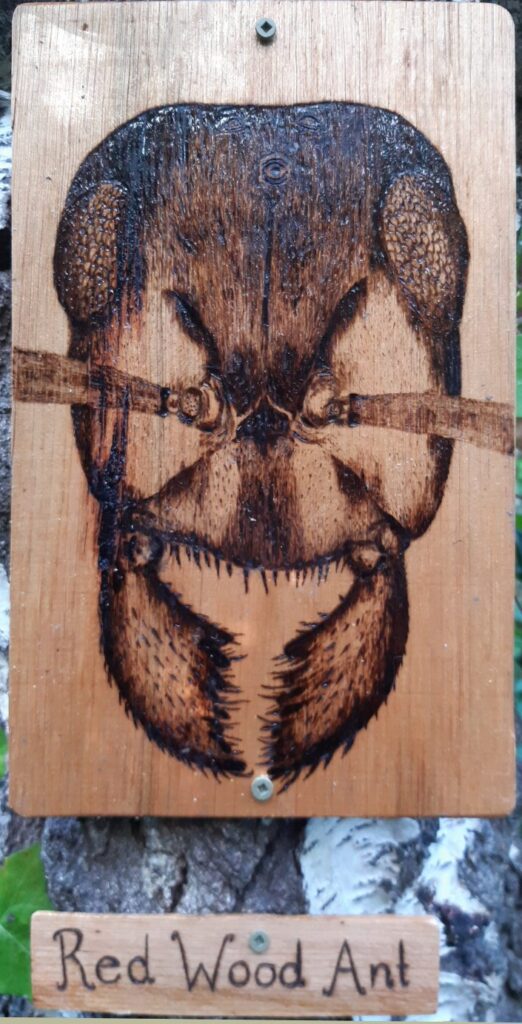
If not evil, the Red Wood Ant is definitely fierce and single-minded, as anyone who’s ever been bitten by one can testify. Tara’s fire-etching has brilliantly captured that take-no-prisoners energy with the insect’s smooth bullet head, businesslike antennae, and efficiently-hinged jaws. Take a careful look at those scorched textures at the top of its head.
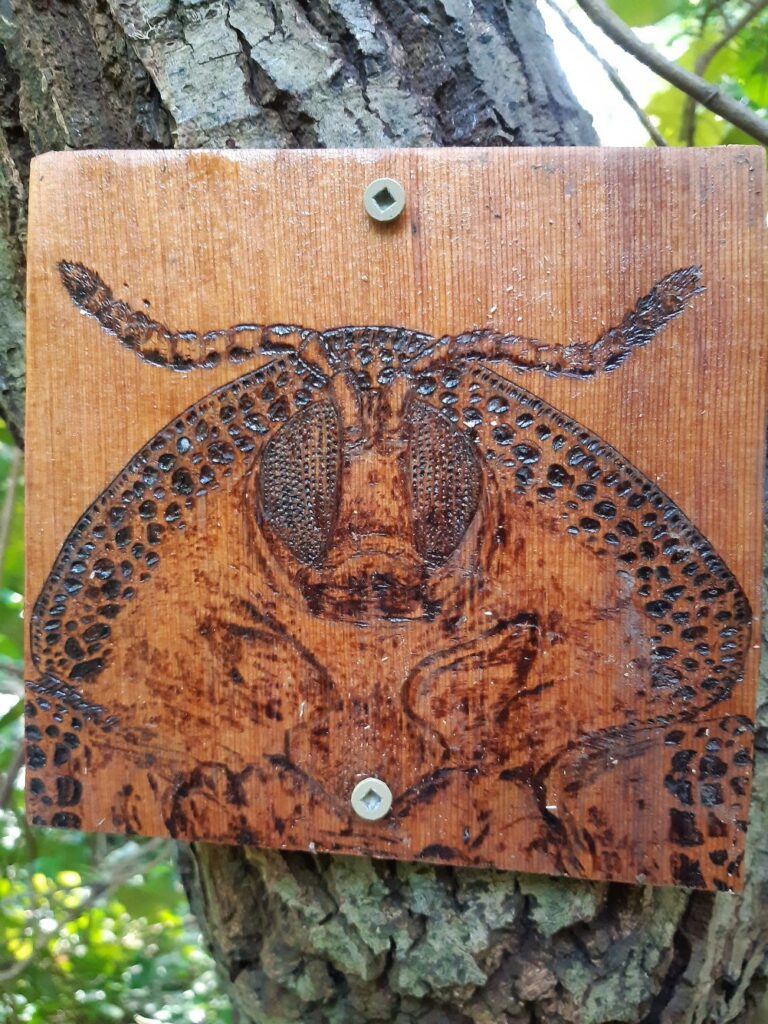
Tara’s Tortoise Beetle shows the distinctly tortoise-like carapace from the underside, its knobbly texture skilfully burnt into the wood, the little head jutting out under the curved rim with the antennae cautiously feeling the outside world for possible danger.
Tara’s website is at https://taralouisehughes.medium.com/
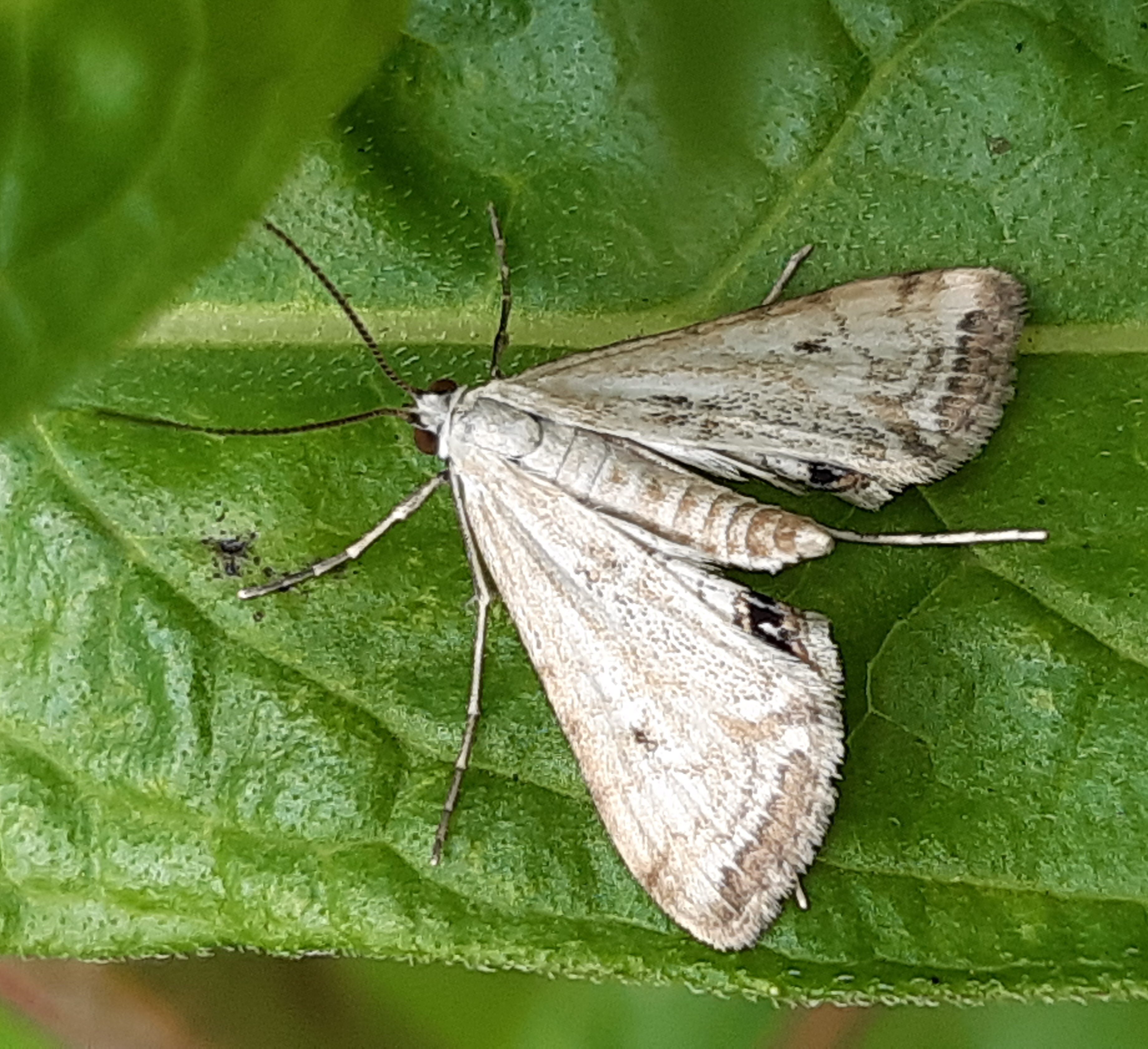
This pretty little moth looks white at first glance, but it isn’t, exactly. There’s a small black spot near the middle of the wing; a slightly checkered border; and a row of black marks with little blue spots near the outer edge of the hind wing. The caterpillars feed on duckweed, so the adults are always near water. This one was just by the boardwalk over the main pond at Gunnersbury Triangle.
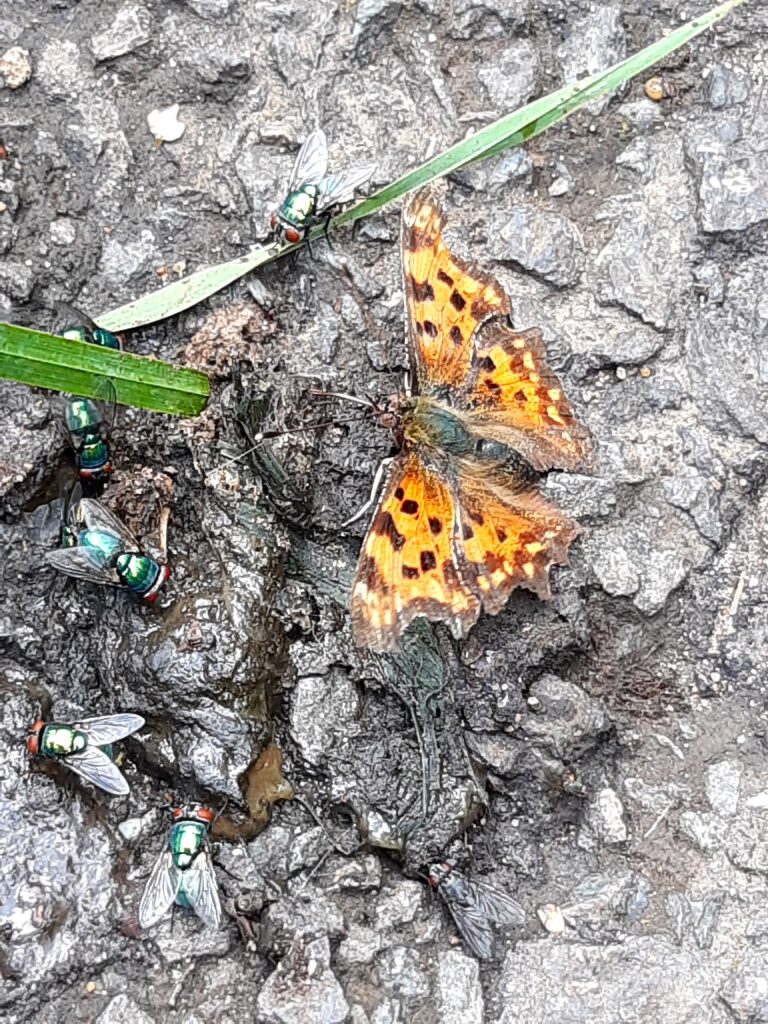
Ah, a Comma butterfly on the path. Ew, but what’s it doing? Those are flies. Greenbottles. With red eyes. They’re buzzing around a sticky mess. Dog or Fox poo. And, yes, the Comma has its proboscis extended, it’s feeding. On the poo, by preference. No better than the flies!
Actually, quite a few species of butterfly are attracted to sticky messes on the ground; entomologists brew up their own concoctions with beer and treacle (and who knows what else) to attract Purple Emperors down from the tops of their Oak trees.
Somehow this all seems surprising, perhaps because we can’t quite believe that anything so beautifully dressed as a butterfly could have such dirty habits. But then again, being attractive and well-dressed doesn’t guarantee that humans are doing nice things, either.
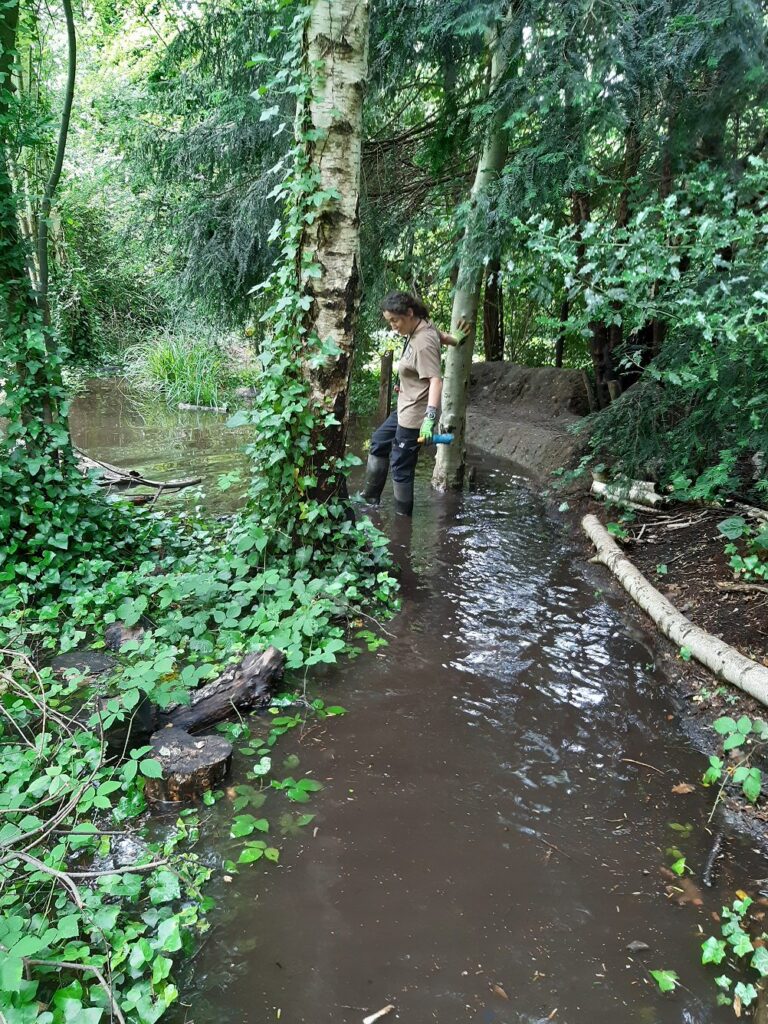
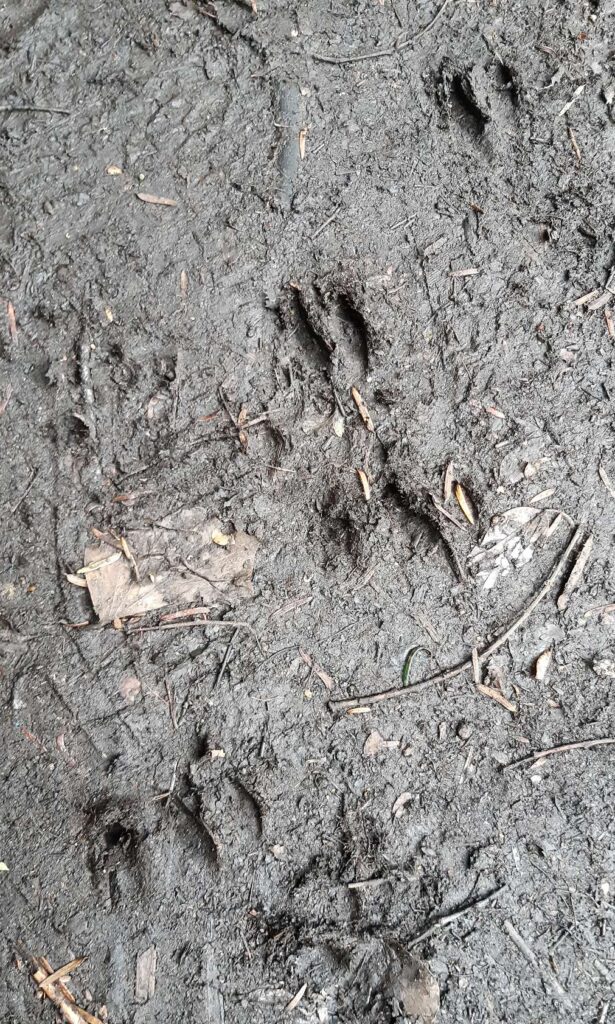
Well, quite the summer surprise: after all these years, none of us had ever seen or heard of a deer in the little urban reserve. But this weekend a visitor shyly checked with the warden whether they could have seen a deer; and a volunteer met the Muntjac, though they didn’t have a camera. Today, the deer had left some fine prints — indeed, trails — in the soft earth on various sections of path. The small size of the prints, and the pointed, cloven hoofs, leave no doubt whatsoever which species made them.
We’re preparing a Nature Trail with little wooden boards for children to find. So Muntjac prints can feature among the other mammal (and maybe bird) footprints that we see on the reserve.
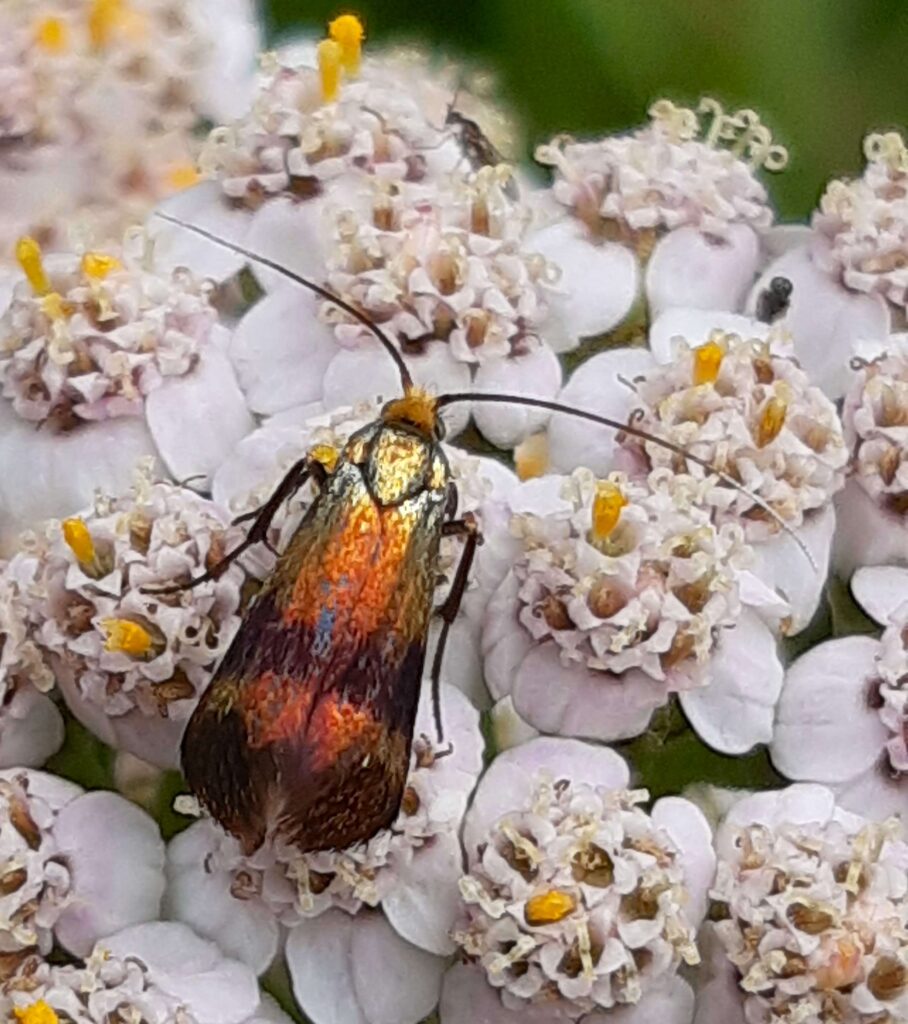
A beautiful shiny Tortricid micro-moth on Hogweed